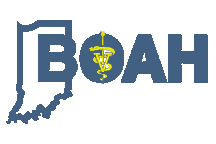The following is a summary of Indiana's animal health laws governing the transportation of equine into Indiana. The identification, movement and testing laws can be viewed in more detail in 345 IAC 1-2, 345 IAC 1-3, and 345 IAC 6. For additional information, contact the Indiana State Board of Animal Health at (317) 544-2400 or toll free at (877) 747-3038 or click here to submit an e-mail inquiry.
Certificate of Veterinary Inspection (CVI)
The CVI must be issued by a licensed and accredited veterinarian within the thirty (30) days immediately prior to the animal entering Indiana. The Extended Equine Certificate of Veterinary Inspection (EECVI) is valid until the expiration date.
Extended Equine Certificate of Veterinary Inspection (EECVI)
The EECVI provided by Global Vet Link is accepted in Indiana. This electronic certificate is valid for up to 6 months and may be used for interstate movements of equine going to multiple destinations, such as shows and trail rides. The EECVI is NOT approved for racetrack movements. Learn more: www.globalvetlink.com/eecvi
Exceptions to CVI Requirement:
Animals used as the mode of transportation for travel into the state and returned directly to the original location
Animals traveling to a facility for veterinary treatment that will return to the state-of origin
Animals traveling through the state without being unloaded
Animals moved directly to an approved livestock facility
Animals consigned for immediate slaughter
Animal Identification
If a CVI is required, official identification is also required and must be included on the CVI. Official identification options for equine include the following:
A description sufficient to identify the individual animal including, but not limited to, the following: name, age, breed, color, gender, distinctive markings, unique and permanent forms of identification when present (e.g. brands, tattoos, scars, cowlicks, blemishes, or biometric measurements)
Electronic identification that complies with ISO 11784/11785
Non-ISO electronic identification if applied to the animal on or before March 11, 2014
Digital photographs sufficient to identify the individual animal
For additional information on ID requirements go to: www.in.gov/boah/traceability-and-premise-id/equine/
Pre-entry Permit
Interstate travel: No permit is required for movement of equine into the state of Indiana from other states.
International travel: Permits are required for horses imported from a country where Contagious Equine Metritis (CEM) exists or a country that trades horses freely with a country in which CEM exits. The United States is free of CEM.
Indiana is approved to have private CEM quarantine facilities for testing and treatment of horses from CEM infected countries.
Testing
Equine Infectious Anemia (EIA)
Equine must be tested for EIA (sometimes called a "Coggins test") within the 12 months immediately prior to an animal entering Indiana. Animals that test positive for EIA may not enter Indiana. The ELISA and AGID tests for EIA are accepted.
The following equine are exempt from the EIA test requirement:
Suckling foals that are accompanied by their dam, when the dam has tested negative for EIA within the last twelve months.
Animals moved directly to a licensed livestock market, if the market facility collects a sample and submits it for EIA testing immediately upon arrival at the market.
Animals consigned for immediate slaughter.
Contagious Equine Metritis (CEM)
The Indiana Board of Animal Health has specific permitting, quarantine, and testing requirements for equine imported from a region where CEM exists or a region that trades horses freely with a region in which CEM exists. If you would like to import equine to Indiana from such a region, contact BOAH at (317-544-2400) for guidance on these requirements.
Vaccination
None required
Exhibition
If the animal is to be entered in a livestock exhibition in Indiana, see also the Indiana exhibition requirements.
Exhibition Requirements.
